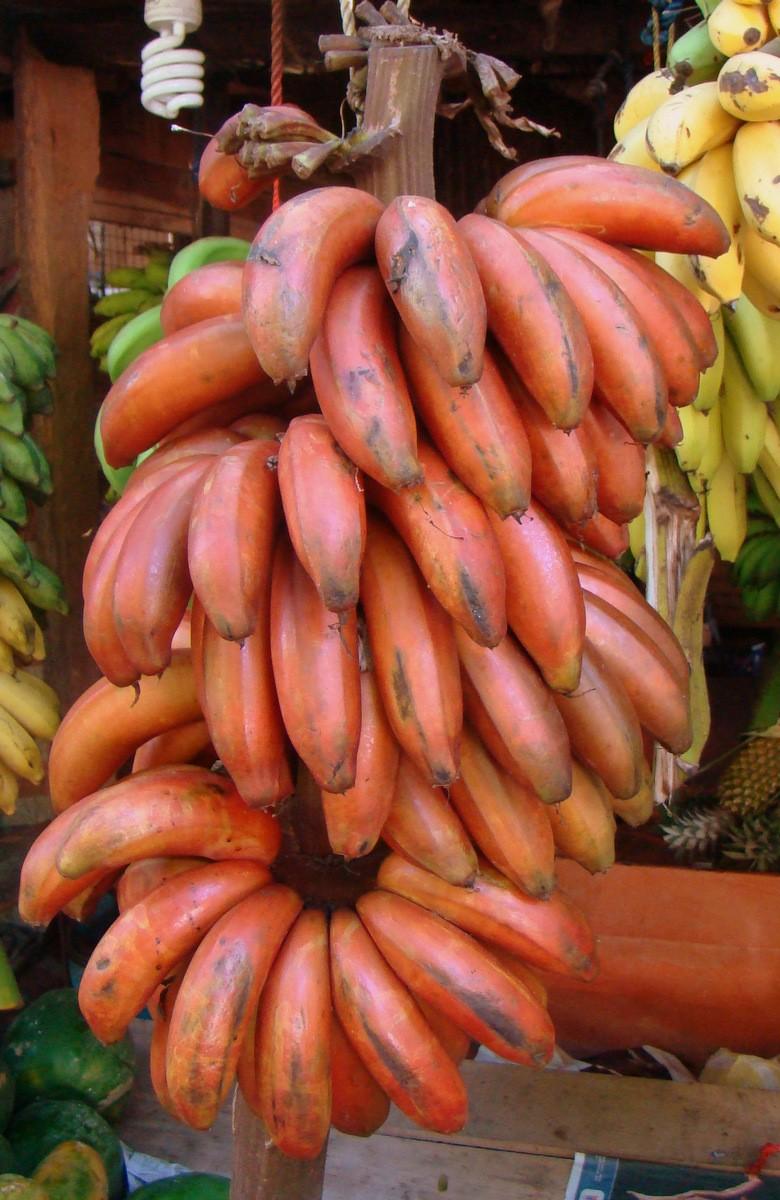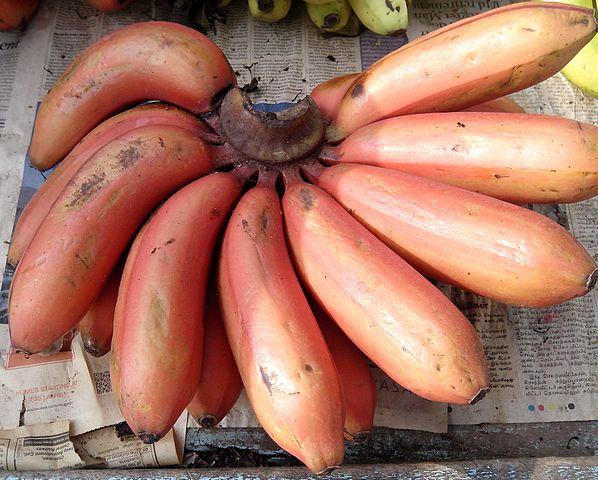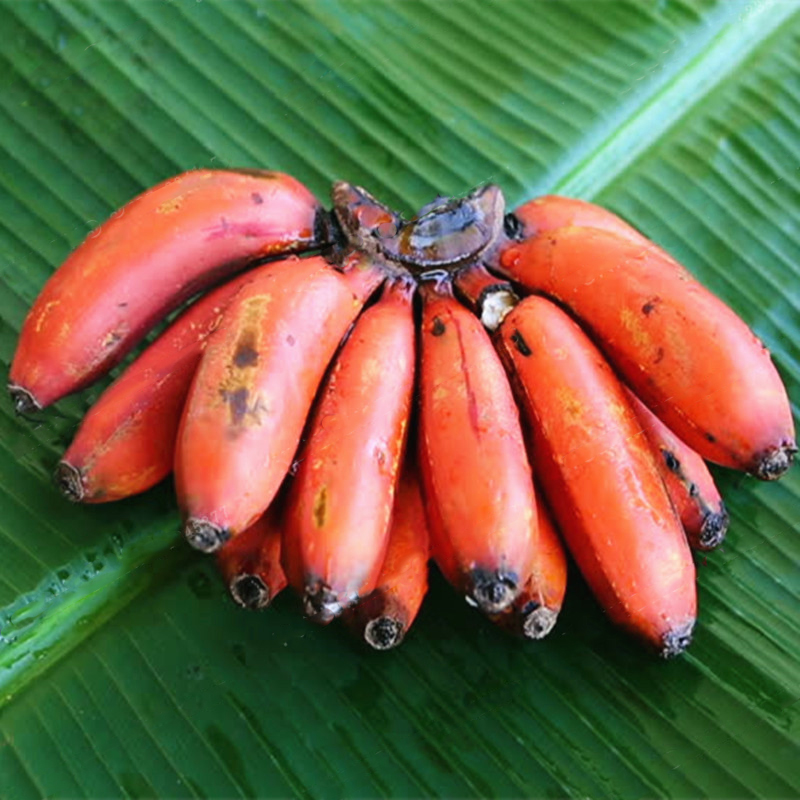Guyanese are always finding name for something. One such thing is the red banana which is also known as ‘buck banana’ or ‘red buck banana’. This fruit is somewhat rare on the market but can be found in the rural areas regardless. Buck banana have a reddish-purple hue but, some folks believe its not red but purple or rust colored instead. The fruit is green at first and then gradually change to red and then purple/yellow as they begin to ripen.
Due to the rarity of the fruit, its priced higher than the other bananas. Moreover, even though it is sold by a few vendors, there is much uncertainty about a supplier.
Origin Buck Banana
The banana spread to Southeast Asia, and through trade routes spread to other parts of the world, including East Africa and South America. The rootstocks are said to have been packed onto a ship of Tomas de Berlanga, a Portuguese Franciscan monk, who brought them to the Caribbean island of Santo Domingo from the Canary Islands in 1516.
Scientific Classification
Its official scientific name is “musa acuminate (AAA Group)”, belonging to the Cavendish group (AAA), a cultivar of the wild banana Musa acuminate
Benefits of Buck Banana
1. A great source of vitamin B is the banana
Vitamin B6 from bananas is easily absorbed by your body and a medium-sized banana can provide about a quarter of your daily vitamin B6 needs.
 Vitamin B6 helps your body:
Vitamin B6 helps your body:
- produce red blood cells,
- metabolise carbohydrates and fats, turning them into energy,
- metabolise amino acids,
- remove unwanted chemicals from your liver and kidneys, and
- maintain a healthy nervous system.
Vitamin B6 is also good for pregnant women as it helps meet their baby’s development needs.
2. Bananas are respectable sources of vitamin C
You may not associate bananas with vitamin C but a medium-sized banana will provide about 10% of your daily vitamin C needs.
Vitamin C helps:
- protect your body against cell and tissue damage,
- your body absorb iron better,
- your body produce collagen – the protein which holds your skin, bones and body together, and
- support brain health by producing serotonin, a hormone that affects our sleep cycle, moods, and experiences of stress and pain.
3. Manganese in bananas is good for your skin
Approximately 13% of your manganese need is provided in one medium-sized banana. Manganese helps your body make collagen and protects your skin and other cells against free radical damage.
4. Potassium in bananas is good for your heart health and blood pressure
A medium-sized banana will provide around 320-400 mg of potassium, which meets about 10% of your daily potassium needs.
The purpose of potassium is to help your body, maintain a healthy heart and blood pressure. Adding to that it contains sodium which is low. The low sodium and high potassium combination helps to regulate high blood pressure.
5. Bananas can aid digestion and help beat gastrointestinal issues
Soluble and insoluble fibre play an important role in your health and a medium sized banana contributes about 10-12% of your daily fibre needs. Soluble fibre helps your body control your blood sugar level and get rid of fatty substances such as cholesterol. Insoluble fibre adds weight and softness to stools, which makes it easy for you to have regular bowel movements. This aids in allowing you to have a healthy gut and to keep it safe from harmful bacteria.
Bananas, especially newly-ripened ones, contain starch that does not digest (resistant starch) in your small intestine and is able to pass into the large intestine. Such bananas help you manage your weight better as you stay full for longer.
Given such benefit, it is safe to stay one can overpower gastrointestinal issues such as:
- constipation,
- stomach ulcers, and
- heartburn
6. Bananas give you energy
Three natural sugars found in banana are sucrose, fructose and glucose which allows you to have a fat and cholesterol-free source of energy. As such, bananas are ideal, especially for children and athletes, for breakfast, as a midday snack or before and after sports.
Nutritional facts
Red bananas are considered to be low in calories and a good source of fibre and potassium. In addi

Source: https://www.medicaldaily.com/5-reasons-eat-red-bananas-instead-yellow-health-benefits-include-strengthened-408466
tion, they are high in Vitamin B6 and a good source of vitamin C as mentioned earlier.
Overall, bananas have been modified over the years by humans where it is said they have crossed two varieties of African wild bananas, the Musa acuminate and the Musa baalbisiana, got rid of the many seeds, and improved the flavour and texture to its present soft and sweet flavour.
| Calories | 89 |
| Water | 75 % |
| Protein | 1.1 g |
| Carbs | 22.8 g |
| Sugar | 12.2 g |
| Fiber | 2.6 g |
| Fat | 0.3 g |
| Saturated | 0.11 g |
| Monounsaturated | 0.03 g |
| Polyunsaturated | 0.07 g |
| Omega-3 | 0.03 g |
| Omega-6 | 0.05 g |
How to eat it
These bananas are mainly eaten raw or added to desserts and salads as these are very healthy and rich in taste.
Buck Banana in Guyana
In Guyana there is neither evidence of official export of the red banana nor large scale cultivation of the fruit.
However, across the world, red bananas come in varying shades of red, names and sizes. In Guyana it is described as being about the same size as the apple banana in addition to apple banana and cayenne banana.
Article References
- https://www.guyanatimesinternational.com/?p=36944
- https://www.healthxchange.sg/food-nutrition/food-tips/good-reasons-eat-banana-today
- https://www.healthline.com/nutrition/foods/bananas#section1







